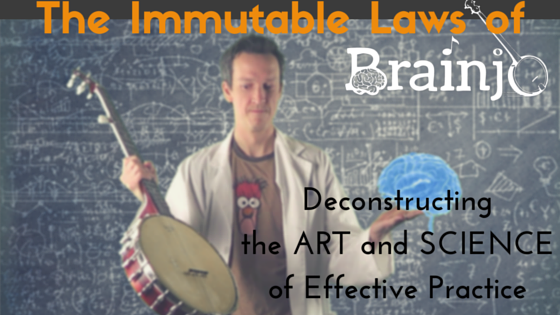Episode 20: 5 Reasons Why You’re Playing Has Stalled (and what to do about it!)
If you’ve been at this banjo thing for any length of time, you’ve been there.
Gotten stuck. Hit the wall. Plateaued.
To some degree, this is simply a natural part of the learning process, as I’ve discussed before. Some of the changes that must occur in the brain to support banjo playing take a bit of time to come to fruition. That’s why Brainjo Law #18 says we should expect our progress to look like a staircase, not a straight line.

But in this installment, I’m referring to something more than just a temporary pause in progress.
I’m referring to those times when you’re truly stuck. When you feel like you’ve gotten as far as you can get, and you don’t really know how to move forward. Or if moving forward is even an option.
Hitting this wall is very common. Masters don’t make their way to the apex of expertise because they never hit that wall, they got there because they always found a way through it.
After all, studies show the single greatest motivating factor for learning is progress. So when you get stuck and growth stalls, guess what happens next? Another banjo starts gathering dust.
So in this installment of the Laws of Brainjo, I’ll be reviewing what I see as 5 of the most common reasons why folks hit the wall, along with a host of solutions to help you blast through it.
(RELATED: The “Breakthrough” Banjo course to prevent folks from hitting the wall, or to make sure that, if you do, you have the tools needed to “break through it. Click here to learn more.)
Reason #1: You’re Not Inspired
Life is full of ebbs and flows. In the beginning, you can’t put the banjo down. You can’t even think about anything else but the banjo, and you can’t imagine how you ever wanted to do anything else with your time.
As infatuation wanes, as is natural, you may find yourself losing interest, and you wonder where the fireworks went.
Sometimes, this is just a natural part of every relationship, and maybe it’s just because the banjo just isn’t the right musical mate. But what if, on the other hand, you want to rekindle the flame, but you just can’t generate a spark?
WHAT TO DO:
- Reconnect with what got you here. Chances are, you started playing the banjo for a reason. Maybe a band or player you heard, a festival you went to, or even just one song. Remember and revisit those early experiences.
- Seek out players that inspire you. Find a festival or jam. Or, if possible, sign up for a banjo camp. For me, there’s nothing more inspiring than being around a group of accomplished musicians, and I always come away with my motivational tank overflowing. If you can’t do the live thing for whatever reason, go on a youtube expedition (or any other place online you like to find music), and don’t come up for air until you’ve bookmarked some favorites, and revisit them whenever you need an inspiratory jolt.
Reason #2: Resting On Your Laurels
Once you get to a certain level of proficiency, it’s really easy to get stuck in a rut with your practicing. You may also feel like you must spend most, if not all, of that practice time just maintaining your skills and repertoire.
But, more than likely, that’s overkill. After all, there’s a reason that riding a bike is, well, “like riding a bike.” You can go years without doing so and, after just a bit of time to get the rust off, pick up right where you left off.
Once you’ve created a mature, subconscious neural network – or “zombie subroutine” – it’s yours for the long haul. So if you practice your old stuff, do it because you WANT to, not because you NEED to.
WHAT TO DO: Create a system for your practice that ensures you’re always dedicating some of your time to new material (new tunes, techniques, etc.).
Reason #3: Not Seeking Out New Sources
If all goes well in our banjo learning journey, we become increasingly proficient at taking the sounds in our mind and transferring them through the banjo.
As stated in Episode 11, musical fluency and improvisation is predicated on the ability to map musical ideas (and the neural networks that represent them) onto motor programs. This means that once musical fluency has developed, our playing is only limited by the sounds we can imagine.
And one of the best ways to stoke that imagination, and to fill your head with new sonic possibilities, is to find new sources that inspire you.

More than likely, when you first started out, you had one or more players who’s picking you aspired to. Players who were part of the reason you ventured down this road to begin with.
Be it Earl, Doc, J.D., or Tommy, it’s likely that, in the beginning, there was probably someone who’s sounds you couldn’t get out of your head, and who’s music you spent lots of time listening to.
And, whether you realized it or not, all that listening was a fundamental ingredient in your growth as a player.
WHAT TO DO:
- Seek out new sources to obsess over, especially those with styles that differ from your own. Pay attention to the players who make your ears perk up when you listen to them, and see if you can figure out what it is they do that makes that happen. If you can, learn more about their musical story, and find a way to emulate their journey in your own way (Remember Brainjo Law #1: to learn to play like the masters, you must learn to play like the masters).
- Build your imagination muscle. When listening to music, imagine what you’d play along with it – or how you’d adapt it – on the banjo (regardless of whether you have the technical skills needed to play it just yet).

Reason #4: Staying In Your Comfort Zone
The research on learning is clear: we only improve when we practice at the edge of our limits, when we deliberately stretch the boundaries of what we’re capable of, and push ourselves outside of our comfort zone.
Yet, as our skills progress and the range of our automatic skill set expands, it’s natural to resist going outside of that comfort zone. After all, you’re no longer a beginner, so why revisit those early days of struggle and slow-going?
WHAT TO DO:
- Embrace the struggle. Realize that the struggle represents opportunity for growth. Rather than avoid the things that are awkward and uncomfortable, seek them out, cause that’s where the magic happens.
- Break the “rules.” Don’t be afraid to color outside of the lines. This one is especially applicable to banjoists, who find themselves learning an instrument that’s tightly linked to a musical tradition. It takes courage to step outside the bounds of that tradition, to ignore the dogmatic and vocal minority who claim that there’s only one right way to play the banjo (there isn’t!). Regardless of whether you desire is to stick with the banjo’s traditional repertoire or venture to less trodden lands, there’s great value in spreading your wings.
- Try adapting some of your favorite music from another genre to the banjo, one you’ve never tried on the banjo, or simply try to jam along. Or listen to a favorite musician on another instrument or even another banjo style (clawhammer, bluegrass, old time fingerstyles, Minstrel, Dixieland, Irish tenor, and so on), and try to emulate that sound in your style. Some of my biggest personal breakthroughs happened doing just that. Even if it doesn’t work out, you’ll have undoubtedly learned something.

Reason #5: You’ve reached the limits of your neural networks
Neuroplasticity, or our ability to continue to mold our brain to suit our needs throughout life, is a phenomenal, awesome gift.
But, as Peter Parker knows, with great power comes great responsibility. Because while we can construct new neural networks from scratch, once those networks are fully formed, we have very little control over them. On the one hand, it’s this transition of conscious construction to unconscious execution that allows our playing to ultimately become effortless and automatic, freeing up our attentional resources to focus on the more subtle nuances of music making.
Yet, once these mature networks are performed, and shift from the conscious to the subconscious is complete, they also constrain our behavior (ever learned a tune entirely from tab and then tried to pick it another way?! Darn near impossible, ain’t it?!). This is the double edged sword of neuroplasticity, and the biological explanation for why “old habits die hard.”
WHAT TO DO: The best strategy is to avoid building neural networks that don’t suit your goals (and the Brainjo Method was created to make sure this doesn’t happen!)
But if you find yourself unable to break free of old and bad habits, it’s best to cut your losses, and build new ones. Yes, it means going back to the drawing board for a bit, but in the end it’ll be well worth it.
There Is No Bottom
When you get down to it, there’s more that can be done on the banjo than any one person can squeeze into a single lifetime. But it can be easy to miss the forest for the trees, to fall into old routines and habits, and lose sight of all that’s still possible.
Keep looking for ways to grow and stretch, and this amazing musical journey will never ever end. There is no bottom.

